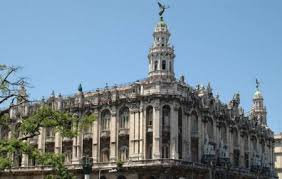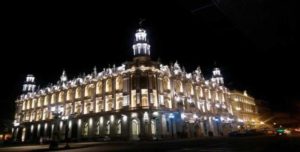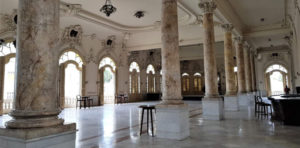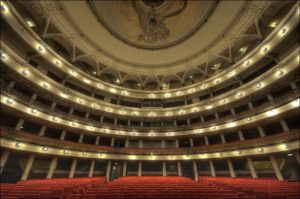 EL GRAN TEATRO DE LA HABANA, ANTIGUO CENTRO GALLEGO DE CUBA.
EL GRAN TEATRO DE LA HABANA, ANTIGUO CENTRO GALLEGO DE CUBA.
El Gran Teatro de La Habana, hoy Ballet Nacional de Cuba, fue durante muchos años el Teatro que albergó al Gran Palacio Centro Gallego en La Habana. Su construcción fue pagada por los inmigrantes gallegos de La Habana para servir como su centro social comunitario. Ubicado en el Paseo del Prado, sus instalaciones incluyen teatros, una sala de conciertos, salas de conferencias, una sala de proyección de videos, así como una galería de arte, un centro coral y varias salas de ensayo para compañías de danza.
Fue diseñado por el arquitecto belga Paul Belau y construido por Purdy y Henderson, ingenieros en 1914 en el sitio del antiguo Teatro Tacón.

EL GRAN TEATRO DE LA HABANA, 1915.
Desde su inicio en 1838, en ese momento ‘El Teatro Tacón’ había ocupado la parte noroeste del sitio delimitado por Paseo del Prado y Calle Consulado y Calles San Rafael y San José. Su auditorio albergaba artistas europeos como Enrico Caruso y Sarah Bernhardt. Durante los primeros años de la independencia cubana, cuando miles de inmigrantes llegaron a Cuba desde España, se construyó un nuevo edificio alrededor de la sala de conciertos del Teatro Tacón. Originalmente conocido como el Centro Gallego de La Habana, el edificio está decorado con esculturas de Giuseppe Moretti que representan benevolencia, educación, música y teatro.
Actualmente, el lugar principal es el Auditorio García Lorca, con asientos para 1,500 personas, ofrece un hogar para la Compañía Nacional de Ballet de Cuba, y para otras compañías de danza y actuaciones musicales. Durante los siglos XIX y XX, las actuaciones que tuvieron lugar en su escenario incluyen a Ole Bull, Enrico Caruso, Fanny Elssler, Jenny Lind, Anna Pavlova, Antonia Mercé, Ruth Saint-Denis, Ted Shawn, Teresa Carreño, Vicente Escudero, Vicente Escudero, Maya Plisetskaya, Clorinda Corradi, Sarah Bernhardt, Carla Fracci y Alicia Alonso, así como compañías como el American Ballet Theatre, el Royal Winnipeg Ballet, el ballet de Antonio Gade, el Ballet del Teatro Colón de Buenos Aires, el Ballet Folclórico de México, entre otros. compañías de ballet.
ARQUITECTURA.
El edificio del Centro Gallego a Renacimiento Barroco, fue construido alrededor de la antigua sala de conciertos del Teatro Tacón ubicado en la esquina de Calles de San Rafael y Consulado. El arquitecto Paul Belau, arquitecto del Palacio Presidencial, y la firma estadounidense Purdy y Henderson, Ingenieros, mantuvieron el teatro original y construyeron el Centro Gallego, una adición al edificio de estilo renacentista barroco que amplió las funciones de apoyo de la sala de conciertos e introdujo un elaborado sistema de circulacion. El exterior del Teatro Tacón original recibió un nuevo revestimiento de piedra para armonizar con el nuevo exterior del Centro Gallego.
ESCULTURA.
Hay un grupo de cuatro esculturas en mármol blanco, parte de un grupo de noventa y siete, de Giuseppe Moretti y Geneva Mercer que representan la caridad, la educación, la música y el teatro.
Una escultura de bronce fue revelada en 2018 por el escultor cubano José Villa Soberón, escultura de Alicia Alonso en el vestíbulo del Gran Teatro. La escultura se llama Giselle por el ballet romántico que llevó a la legendaria bailarina a la fama mundial. Giselle se estrenó en 1841 en la Ópera de París y es uno de los títulos principales dentro del repertorio del Ballet Nacional de Cuba. Por lo tanto, no es casualidad que el artista haya elegido este clásico para representar la figura.
Hasta su confiscación por el gobierno cubano, durante los siglos XIX y XX, las actuaciones que tuvieron lugar en su escenario incluyen Ole Bull, Enrico Caruso, Fanny Elssler, Jenny Lind, Anna Pavlova, Antonia Mercé, Ruth Saint-Denis, Ted Shawn, Teresa Carreño, Vicente Escudero, Maya Plisetskaya, Clorinda Corradi, Sarah Bernhardt, Carla Fracci, así como compañías como el American Ballet Theatre, el Royal Winnipeg Ballet, el ballet de Antonio Gade, el Ballet del Teatro Colón de Buenos Aires y el Ballet Folclórico de Mexico

* RECOMIENDENOS A SUS AMISTADES * PREFIERA A NUESTROS SPONSORS. *
 EL GRAN TEATRO DE LA HABANA, ANTIGUO PALACIO “CENTRO GALLEGO DE CUBA”.
EL GRAN TEATRO DE LA HABANA, ANTIGUO PALACIO “CENTRO GALLEGO DE CUBA”.
Gran Teatro de La Habana is a theater in Havana, Cuba, home to the Cuban National Ballet which housed for many years the Palacio Centro Gallego in Havana. Its construction was paid for by the Galician immigrants of Havana to serve as their community-social center. Located in the Paseo del Prado, its facilities include theatres, a concert hall, conference rooms, a video screening room, as well as an art gallery, a choral center, and several rehearsal halls for dance companies.
It was designed by the Belgian architect Paul Belau and built by Purdy and Henderson, Engineers in 1914 at the site of the former Teatro Tacón.
EL GRAN TEATRO DE LA HABANA, 1915.
Since its inception in 1838, at that time ‘El Teatro Tacón’ had occupied the north-western part of the site bounded by Paseo del Prado and Calle Consulado and Calles San Rafael and San José. Its auditorium hosted such European artists as Enrico Caruso and Sarah Bernhardt. During the first years of Cuban independence when thousands of immigrants arrived in Cuba from Spain, a new building addition was constructed around the concert hall of Teatro Tacón. Originally known as the Centro Gallego de La Habana, the building is decorated with sculptures by Giuseppe Moretti representing benevolence, education, music, and theatre.
Currently, the principal venue is the García Lorca Auditorium, with seats for 1,500 persons, it provides a home for the Cuban National Ballet Company, and for other dance companies and musical performances. During the 19th and 20th century, performances that took place on its stage include Ole Bull, Enrico Caruso, Fanny Elssler, Jenny Lind, Anna Pavlova, Antonia Mercé, Ruth Saint-Denis, Ted Shawn, Teresa Carreño, Vicente Escudero, Maya Plisetskaya, Clorinda Corradi, Sarah Bernhardt, Carla Fracci and Alicia Alonso, as well as companies such as the American Ballet Theatre, the Royal Winnipeg Ballet, Antonio Gade’s ballet, the Ballet of the Colón Theatre of Buenos Aires, the Ballet Folclórico of Mexico, plus other ballet companies.
ARCHITECTURE.
Detail showing the architectural connection of the Centro Gallego to the new stone facing of 1838 Teatro Tacon on Calle San Rafael.
The Centro Gallego a Baroque Revival building,[b] was built around the old concert hall of the Teatro Tacón located at the corner of Calles of San Rafael and Consulado. Architect Paul Belau, an architect of the Presidential Palace, and the U.S. firm Purdy and Henderson, Engineers, kept the original theatre and built the Centro Gallego, a Baroque Revival style building addition that enlarged the support functions of the concert hall and introduced an elaborate system of circulation. The exterior of the original Teatro Tacón received a new stone facing to harmonize with the new exterior of the Centro Gallego.
SCULPTURE.
There is a group of four sculptures in white marble, part of a group of ninety-seven, by Giuseppe Moretti and Geneva Mercer representing the charity, education, music, and theater.
A bronze sculpture was revealed in 2018 by the Cuban sculptor José Villa Soberónsculpture of Alicia Alonso in the lobby of the Gran Teatro. The sculpture is named Giselle after the romantic ballet that brought the legendary dancer to world fame. Giselle premiered in 1841 at the Paris Opera and is one of the main titles within the repertoire of the National Ballet of Cuba. It is, therefore, no coincidence that the artist chose this classic to represent the figure.
Until its confiscation by the Cuban Government, during the 19th and 20th century, performances that took place on its stage include Ole Bull, Enrico Caruso, Fanny Elssler, Jenny Lind, Anna Pavlova, Antonia Mercé, Ruth Saint-Denis, Ted Shawn, Teresa Carreño, Vicente Escudero, Maya Plisetskaya, Clorinda Corradi, Sarah Bernhardt, Carla Fracci as well as companies such as the American Ballet Theatre, the Royal Winnipeg Ballet, Antonio Gade’s ballet, the Ballet of the Colón Theatre of Buenos Aires, the Ballet Folclórico of Mexico.
Agencies/ Wiki/ Internet Photos/ Arnoldo Varona/ www.TheCubanHistory.com
THE CUBAN HISTORY, HOLLYWOOD.
 * RECOMIENDENOS A SUS AMISTADES * PREFIERA A NUESTROS SPONSORS. *
* RECOMIENDENOS A SUS AMISTADES * PREFIERA A NUESTROS SPONSORS. *







